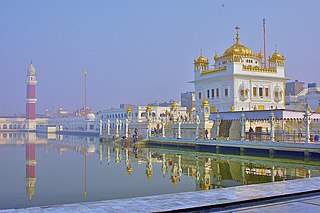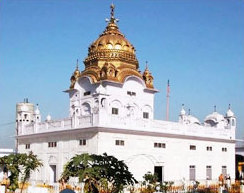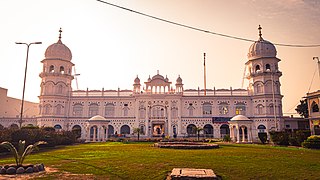| Part of a series on |
| Sikhism |
|---|
 |
Sikh Pilgrimage to Pakistan is a book by Anup Singh Choudry and Hardip Singh Chowdhary, published by Gurbani Centre, UK, in 1985 and printed in Great Britain by Jarrold and Sons Ltd, Norwich.
| Part of a series on |
| Sikhism |
|---|
 |
Sikh Pilgrimage to Pakistan is a book by Anup Singh Choudry and Hardip Singh Chowdhary, published by Gurbani Centre, UK, in 1985 and printed in Great Britain by Jarrold and Sons Ltd, Norwich.
The book is aimed at visitors to Sikh shrines in Pakistan. With the relaxation of the visa requirements for Indian citizens in 2005, increasing numbers of Sikh visitors are travelling to Pakistan. [1] Guru Nanak, the founder of the Sikh religion was born on the outskirts of Lahore, [2] and the book contains illustrations of various sacred places in Pakistan connected with the Guru from his birth to death. [3] The events of the first Guru's life are now represented by sacred Gurdwaras, which are documented in this book. [4]
Thousands of Sikhs visit Pakistan each year to celebrate the birth anniversary of their founder, Guru Nanak, at Nankana Sahib, his birthplace. [5] This illustrated guide introduces most of the Sikh shrines in Pakistan connected with the founding Guru, to help prospective pilgrims who wish to visit these shrines. [6]
The chapter on the Sikh Raj gives some background to the Sikhs' history and their present political status, referencing some recent events of historical importance and significance.

Nankana Sahib is a city and capital of Nankana Sahib District in the Punjab province of Pakistan. It is named after the first Guru of the Sikhs, Guru Nanak, who was born in the city and first began preaching here. Nankana Sahib is the most important religious site for the Sikh religion. It is located about 91 km (57 mi) west of Lahore and about 75 km (47 mi) east of Faisalabad. According to the census of 2017 the city has a population of 79,540 inhabitants. Until 2005, it was the part of Sheikhupura District.
A gurdwara is a place of assembly and worship for Sikhs. Sikhs also refer to gurdwaras as Gurdwara Sahib. People from all faiths are welcomed in gurdwaras. Each gurdwara has a Darbar Sahib where the current and everlasting guru of the Sikhs, the scripture Guru Granth Sahib, is placed on a takhat in a prominent central position. The raagis recite, sing, and explain the verses from the Guru Granth Sahib, in the presence of the congregation.
The following outline is provides an overview of Sikhism, or Sikhi.

Vaisakhi, also pronounced Baisakhi, marks the first day of the month of Vaisakha and is usually celebrated annually on 13 or 14 April as the solar new year. It is additionally a spring harvest festival in the Punjab.

Tarn Taran Sahib is a city in the Majha region of the state of Punjab, in northern India. It is the district headquarters and hosts the municipal council of Tarn Taran district. Gurdwara Sri Tarn Taran Sahib, a prominent Sikh shrine is located in the central part of the city. Near the famous oldest city in Tarn Taran called mattewal. The village of Dilpreet Singh Randhawa who won the gold medal in summer Olympic Games.

Takht Sri Patna Sahib also known as Takhat Sri Harimandir Ji, is a Gurdwara in the neighbourhood of Patna Sahib, India. It was to commemorate the birthplace of Guru Gobind Singh, the tenth Guru of the Sikhs on December 1666. It was built by Maharaja Ranjit Singh (1780-1839), the first Maharaja of the Sikh Empire, who also built many other Gurdwaras in the Indian subcontinent. The current shrine of Patna Sahib or Takht Sri Harmandirji Sahib was built in the 1950s.

Guru Nanak Dev Ji Gurpurab, also known as Guru Nanak's Prakash Utsav and Guru Nanak Dev Ji Jayanti, celebrates the birth of the first Sikh guru, Guru Nanak. One of the most celebrated Sikh gurus and the founder of Sikhism, Guru Nanak Dev is highly revered by the Sikh community. This is one of the most sacred festivals in Sikhism, or Sikhi.

The Nanakshahi calendar is a tropical solar calendar used in Sikhism. It is based on the "Barah Maha", a composition composed by the Sikh gurus reflecting the changes in nature conveyed in the twelve-month cycle of the year. The year begins with the month of Chet, with 1 Chet corresponding to 14 March. The reference epoch of the Nanakshahi calendar is the birth of Guru Nanak Dev, corresponding to the year 1469 CE.

Sikhism in Pakistan has an extensive heritage and history, although Sikhs form a small community in Pakistan today. Most Sikhs live in the province of Punjab, a part of the larger Punjab region where the religion originated in the Middle Ages, with some also residing in Peshawar in the Khyber-Pakhtunkhwa province. Nankana Sahib, the birthplace of Guru Nanak Sahib Ji, the founder of Sikhism, is located in Pakistan's Punjab province. Moreover, the place where Guru Nanak is believed to have died, the Gurdwara Kartarpur Sahib is also located in the same province.

Dera Baba Nanak is a town and a Municipal council in Gurdaspur district in the state of Punjab, India. Recently in November 2019, a corridor between India and Pakistan has been established at its shrine.

Kartarpur is a town located in the tehsil Shakargarh, Narowal District in Punjab, Pakistan. Located on the right bank of the Ravi River, it is said to have been founded by the first guru of Sikhism, Guru Nanak, where he established the first Sikh commune.

Sikh Architecture is a style of architecture that was developed under Sikh Empire during 18th and 19th century in the Punjab region. Due to its progressive style, it is constantly evolving into many newly developing branches with new contemporary styles. Although Sikh architecture was initially developed within Sikhism its style has been used in many non-religious buildings due to its beauty. 300 years ago, Sikh architecture was distinguished for its many curves and straight lines; Shri Keshgarh Sahib and the Sri Harmandir Sahib are prime examples.

Gurdwara Darbar Sahib Kartarpur, also called Kartarpur Sahib, is a gurdwara in Kartarpur, located in Shakargarh, Narowal District, in the Punjab province of Pakistan. It is built on the historic site where the founder of Sikhism, Guru Nanak, settled and assembled the Sikh community after his missionary travels and lived for 18 years until his death in 1539. It is one of the holiest sites in Sikhism, alongside the Golden Temple in Amritsar and Gurdwara Janam Asthan in Nankana Sahib.

Gurū Nānak, also referred to as Bābā Nānak, was the founder of Sikhism and is the first of the ten Sikh Gurus. His birth is celebrated worldwide as Guru Nanak Gurpurab on Katak Pooranmashi, i.e. October–November.

Gurdwara Janam Asthan, also referred to as Gurdwara Nankana Sahib, is a highly revered gurdwara that was built at the site where the founder of Sikhism, Guru Nanak, was born. The shrine is located in the city of Nankana Sahib, near the city of Lahore in the Punjab province of Pakistan.

Hazur Sahib, also known as Takht Sachkhand Sri Hazur Abchalnagar Sahib, is one of the five takhts in Sikhism. The gurdwara was built between 1832 and 1837 by Nasir-ud-Daulah, Asaf Jah IV upon the request of his friend Maharaja Ranjit Singh (1780–1839) to build the gurudwara. It is located on the banks of the Godavari River at the city of Nanded in the state of Maharashtra, India.

Guru Nanak Jhira Sahib is a Sikh historical shrine situated in Bidar, Karnataka. Gurdwara Nanak Jhira Sahib was built in the year 1948 and is dedicated to the first Sikh guru Guru Nanak. Bidar has a very long association with Sikhism as this is the home town of Bhai Sahib Singh, one of the Panj Pyare, who offered to sacrifice their heads and were later baptised as the first members of the Khalsa.
Religious tourism in India is a focus of Narendra Modi's national tourism policy. Uttarakhand has been popular as a religious and adventure tourism hub.

The Kartarpur Corridor is a visa-free border crossing and corridor, connecting the Gurdwara Darbar Sahib in Pakistan to the border with India. The crossing allows devotees from India to visit the gurdwara in Kartarpur, 4.7 kilometres from the India–Pakistan border on the Pakistani side without a visa. However Pakistani Sikhs are unable to use the border crossing, and cannot access Dera Baba Nanak on the Indian side without first obtaining an Indian visa or unless they work there.

Baba Nanak Shrine, a Sikh Gurdwara in Baghdad, Iraq, which was rediscovered by Sikh soldiers during World War I and was repaired and rebuilt during World War II, by Sikh soldiers again, existed till 2003 in somewhat good shape.